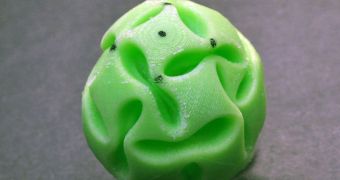Drawing inspiration from a toy they came across by accident, investigators at the Massachusetts Institutes of Technology (MIT), in Cambridge, managed to develop a buckliball, a collapsible structure that features no moving parts. See the video below for a quick glimpse of the buckliball.
The group was actually trying to determine the simplest 3D structure that can use mechanical instability to collapse in a reversible manner. They managed to develop a buckliball that morphs into a rhombicuboctahedron.
The latter is only 46 percent the size of the initial buckling ball. The most interesting part about the structure is that it does not feature any moving parts. Rather, the very structure of its walls is set up in such a way that pulling the air out of the buckliball forces it to collapse.
According to the group, the toy that provided the necessary inspiration featured a complex layout of 26 solid moving elements and 48 rotating hinges. The real challenge was developing a rubbery counterpart that featured no such elements.
Researchers say that the most important components of the hollow, soft rubber buckliball are 24 carefully spaced dimples, which are surrounded by thin ligaments. These ligaments collapse at the exact same time when air is removed from the rubber sphere.
“In civil engineering, buckling is commonly associated with failure that must be avoided. For example, one typically wants to calculate the buckling criterion for columns and apply an additional safety factor, to ensure that a building stands,” researcher Pedro Reis explains.
“We are trying to change this paradigm by turning failure into functionality in soft mechanical structures. For us, the buckliball is the first such object, but there will be many others,” he adds.
Reis holds an appointment as the Esther and Harold E. Edgerton assistant professor of civil and environmental engineering and mechanical engineering at the Institute. He led the team that created the first morphable structure that incorporates buckling as a desirable engineering design element.
Details of the new investigation were published in this week's issue of the esteemed journal Proceedings of the National Academy of Sciences (PNAS). MIT experts say that the new technology could be used for a wide array of applications, from nanotechnology to conducting repairs in space.
The US National Science Foundation (NSF), the Harvard Materials Research Science and Engineering Center, the Harvard University and MIT funded this investigation.

 14 DAY TRIAL //
14 DAY TRIAL // 